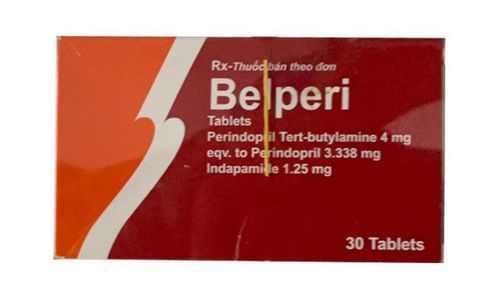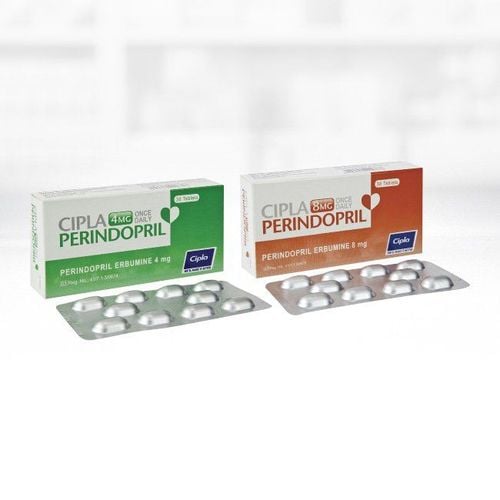This is an automatically translated article.
Hypertension is an extremely common disease, and current treatment regimens tend to combine many active ingredients in one product with the aim of increasing treatment effectiveness as well as patient compliance. A combination antihypertensive product can be mentioned as Naatrixam 1.5/5mg or Natrixam 1.5/10mg.
1. What is Natrixam 1.5/5mg?
Natrixam is a combination tablet between two antihypertensive drugs Indapamide and Amlodipine, commonly in the form of 1.5mg/5mg with 1.5mg Indapamide and 5mg Amlodipine. In addition, there is also a form of Natrilam 1.5mg/10mg containing 1.5mg of Indapamide and 10mg of Amlodipine.
2. What is the effect of the drug Natrixam 1.5mg/5mg?
Natrixam combines 2 active ingredients Indapamide and Amlodipine with the following effects:
Amlodipine is an active ingredient in the group of calcium channel blockers, which directly relaxes smooth muscle in blood vessel walls, thereby bringing effective blood pressure lowering. ; Indapamide is a diuretic, increasing the ability to diuresis, so it also has the effect of lowering blood pressure.
3. Indications and contraindications of the drug Natrixam 1.5/5mg
Indications: Natrixam is used to replace hypertensive patients who have previously used Indapamide and Amlodipine with the same concentration.
Contraindications of the drug Natrixam :
Allergy to Indapamide, Amlodipine, Sulfonamide and Dihydropyridine group drugs or any excipients in the drug Natrixam; Severe renal impairment with creatinine clearance less than 30ml/min; Severe liver failure or complications of hepatic encephalopathy; Hypokalemia ; Women who are breastfeeding; Severe hypotension; Types of shock, including cardiogenic shock; Left ventricular outflow tract obstruction, such as severe aortic stenosis; Hemodynamically unstable heart failure after acute myocardial infarction.
4. Instructions for using the drug Natrixam
Dosage and how to use Natrixam 1.5/5mg in adults:
Take 1 tablet of Natrixam 1.5mg/5mg, 1 time per day, preferably in the morning. Patients need to swallow tablets whole with water, do not chew; Natrilam 1.5mg/5mg is a fixed dose combination drug, so it is not suitable for people using Indapamide and Amlodipine for the first time. Patients should only be treated with Natrixam when they have used the two active ingredients separately with equivalent concentrations; If dose adjustment is required, the patient should be supplemented with single-active products. Dosage of Natrixam in some special subjects:
Children: There are not enough data to prove the safety and effectiveness of Natrixam in this subject; Renal impairment: Contraindicated with severe renal impairment (ClCr < 30ml/min). Patients with mild to moderate renal impairment do not require dose adjustment; Elderly: Hypertension can be treated with Natrixam 1.5mg/5mg and adjust the dose according to renal function; Hepatic impairment: Contraindicated in severe liver failure. In cases of mild to moderate hepatic impairment, the recommended dose of Amlodipine has not been established so far, so caution should be exercised when using Natrixam. It is best to initiate treatment with Amlodipine at the lowest dose of the allowable range.
5. Some warnings and cautions when using Natrixam 1.5mg/5mg
Some special warnings related to Natrixam drug:
Hepatic encephalopathy: People with liver failure when using Indapamide active ingredient increase the risk of hepatic encephalopathy, especially when there is electrolyte imbalance. Patients should immediately discontinue use of Natrixam if hepatic encephalopathy occurs; Photosensitivity: The use of the active ingredient Indapamide increases the risk of photosensitivity and it is recommended to discontinue Natrixam if this occurs. In case it is necessary to use diuretics again, the patient should actively protect the areas of the skin exposed to sunlight. Some issues need to be cautious when using Natrixam:
Hypertensive crisis : The safety and effectiveness of Amlodipine in Natrixam with hypertensive crisis is unknown; Disturbances in water-electrolyte balance: Indapamide diuretic use may lead to the following risks: Hyponatremia: It is necessary to check blood sodium levels before and during the use of Natrixam, especially in elderly subjects. aged or cirrhotic patients; Severe hypokalemia causes arrhythmias, even torsades de pointes and death. Therefore, the patient should have the blood potassium level checked during the first week and then periodically during treatment with Natrixam, especially in the elderly, malnourished, and people taking a lot of drugs. at the same time, cirrhosis with edema and ascites, heart failure, coronary artery disease or long QT interval on ECG; Mild and transient hypercalcaemia, in cases of severe elevation, may be related to hyperparathyroidism and should be discontinued prior to laboratory testing. Effects on blood sugar: Patients treated with Natrixam 1.5/5mg should strictly control blood glucose levels if they have diabetes, especially with hypokalemia; Heart failure: The active ingredient Amlodipine in Naatrixam increases the risk of cardiovascular events, even death, in patients with heart failure, especially severe heart failure (NYHA class III, IV) or congestive heart failure; Renal function: Indapamide diuretics are only fully effective when renal function is normal or renal failure is mild. It should be noted that when starting to use Indapamide can increase blood urea and creatinine; Uric acid: Indapamide is a drug that can increase the risk of gout when blood uric acid levels are high; Excipients: Do not use Natrixam in patients with hereditary problems of galactose intolerance, the Lapp lactase deficiency, glucose-galactose malabsorption.
6. Undesirable effects of the drug Natrixam
Common side effects of Indapamide and Amlodipine in Natrilam include:
Drowsiness, dizziness, headache; palpitations, palpitations, flushing; Digestive disorders, abdominal pain, nausea; Swollen ankles ; Edema, fatigue; Skin rash; Hypokalemia.
7. Drug interactions when treated with Natrixam
7.1. Interactions related to Indapamide Combination is not recommended during treatment with Naatrixam :
Lithium: Indapamide increases lithium concentrations and toxicity. Patients requiring diuretic therapy should be closely monitored for blood lithium levels and dose adjusted accordingly. Indapamide should be used with caution:
Drugs that cause torsades de pointes such as class Ia and class III antiarrhythmics (such as amiodarone, sotalol, dofetilide, ibutilide), some antipsychotics (such as Chlorpromazine, Levomepromazine), benzamide group (amisulpride, sulpiride, sulpiride...) butyrophenone group (such as droperidol, haloperidol) and some other drugs such as intravenous bepridil, erythromycin, mizolastine, moxifloxacin, intravenous vincamine...; Non-steroidal anti-inflammatory drugs including selective COX-2 inhibitors or high doses of salicylic acid (2-3g/day): Combined with Natrilam reduces the antihypertensive effect of Indapamide, in addition to increasing the risk of acute renal failure. (when dehydrated); ACE inhibitors: When combined with Natrixam increases the risk of sudden falls and acute renal failure. Patients with hypertension should discontinue diuretics (e.g. indapamide) at least 3 days prior to initiation of ACE-inhibitor therapy; if necessary, they may be reinstituted later or initiated with a low-dose ACE inhibitor prior to initiation of therapy. gradually increase the dose; Care should be taken when combining Natrixam with drugs that can cause hypokalemia such as amphotericin B (intravenous), corticosteroids (systemic), stimulant laxatives or digitalis. When combined, it is necessary to monitor blood potassium levels, electrocardiogram and adjust the dose when necessary; Baclofen: Increases the antihypertensive effect of Natrixam; Allopurinol: Concomitant treatment with Natrixam may lead to an increased risk of Allopurinol hypersensitivity reactions. Some combinations to consider of Indapamide in Natrixam :
Potassium-sparing diuretics: May increase or decrease blood potassium, so it is necessary to closely control blood potassium, electrocardiogram and consider this combination; Metformin: Combination with diuretics (such as Indapamide) increases the risk of Metformin lactic acidosis; Contrast containing iodinated: Concomitant use of diuretics increases the risk of acute renal failure, so it is important to rehydrate before using iodinated contrast agents; Antidepressants, sedatives increase the hypotensive effect and the risk of orthostatic hypotension of Natrixam; Calcium salts: Co-administration with Natrixam increases the risk of hypercalcemia due to decreased urinary excretion; Corticosteroids, tetracosactide (systemic route): Reduces the antihypertensive effect of Natrixam. 7.2. Interactions Related to amlodipine Dantrolen (infusion): This combination increases the risk of hyperkalemia and should therefore be avoided in people with a potential for malignant hyperthermia; Grapefruit or grapefruit juice: Not recommended in combination with Natrixam, as it may increase the blood pressure lowering effect of Amlodipine; CYP3A4 inhibitors in combination with Natrixam may increase blood levels of Amlodipine, which is more pronounced in the elderly; Inducers of CYP3A4 when co-administered with Natrixam reduce blood levels of amlodipine; Other antihypertensive agents: Additional effects increase the risk of excessive hypotension; Simvastatin: Concomitant use of Amlodipine increases serum concentrations of Simvastatin. Natrixam is used to replace hypertensive patients who have previously used Indapamide and Amlodipine with the same strength. To ensure the effectiveness of treatment and avoid unwanted side effects, patients need to take medicine according to prescription or consult a doctor, professional pharmacist.
Follow Vinmec International General Hospital website to get more health, nutrition and beauty information to protect the health of yourself and your loved ones in your family.
Please dial HOTLINE for more information or register for an appointment HERE. Download MyVinmec app to make appointments faster and to manage your bookings easily.













